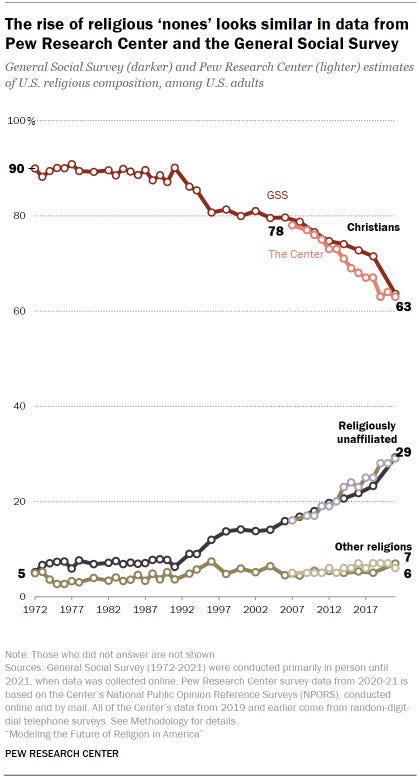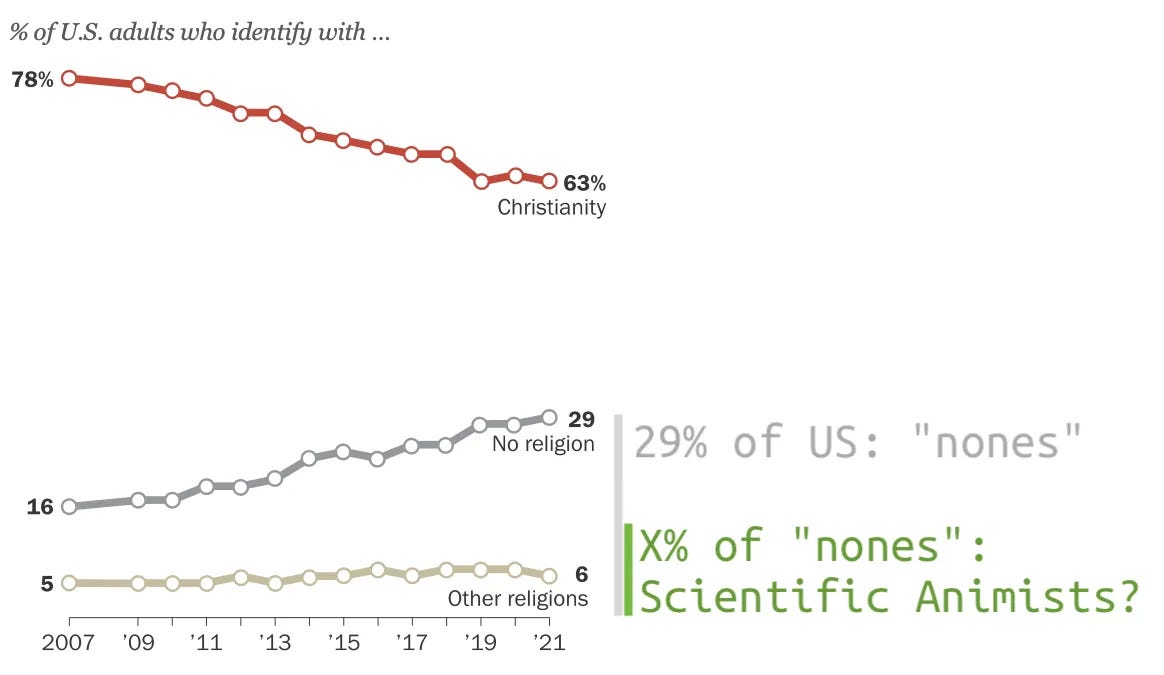
Let’s start with science.
Not “the scientific worldview” that reduces and flattens, that celebrates only human intelligence and justifies materialist exploitation.
But real scientific inquiry. The slow, careful observation of reality; the prioritization of data over ego; the never-fully-arriving. The quest that has given us heart transplants, electronics, pictures of deep oceans and distant worlds.
At this point in history, it seems self-evident that the scientific method works; that we have perhaps no better tool for separating fact—at least measurable fact, or currently-measurable fact—from fiction.
If you agree, then you believe in science.
How about animism?
Do you believe that non-human beings can have experiences of reality that are worth honoring and respecting, despite (or maybe because of!) their mystery? That we live in a world bursting with sentience; with inscrutable forms of consciousness and its analogs; with anima? And that while humans may have a unique role to play in this tangled web of life, we do not sit at its peak, our role is not master/owner, and we may instead be “the younger siblings of creation,”1 with much to learn from our plant and animal teachers?
Then you’re an animist.
Let’s put them together.
Do you believe that, rather than contradicting each other, these two modes of relating to the world are complementary? Symbiotic, even? That the scientific—the “true, selfless desire to understand the world out there through presence, care, measurement, attention, reproduction of experiment”2 —and the animistic—a deep respect and reverence for the aliveness, the experience, the anima of other beings—can mutually support and strengthen each other?
Then you’re a Scientific Animist. Welcome!
As popularized by
The two heaviest-hitting books this project draws from are Braiding Sweetgrass, by Robin Wall Kimmerer, and The Overstory, by Richard Powers. I would say that these books embody and evangelize the Scientific Animist worldview more powerfully than any others I know, though I posit that this worldview did not originate with them. Nothing comes from nothing.
This concept—that science and animism can complement each other—must have been percolating in various heads and conversations for years, prior to those books. But no one, as far as I know, was calling it Scientific Animism back then. Heck, not even those books use the term. I am suggesting this name. Offering, really. I think it’s a great description for these books and the cultural/philosophical movement from which they spring.
In fact, once I had a name for it, I started to notice it everywhere. Poems, sermons, wedding ceremonies, songs, books, podcasts—so many cultural artifacts that already fall within this category, but without a label to tie them together. Scientific Animism is having a moment. It’s in the air, right now. Or maybe not quite airborne yet. Maybe it’s underground; a mycelium network that is almost ready to fruit. It is my hope that this newsletter, this suggested name, might help that process.
(I didn’t invent the term, by the way. As far as I know, Ezra Klein did. In his interview with Richard Powers. “You strike me as something of a scientific animist,” he said.)
What else could it become?
This is the thought experiment that captured me. The exploration that drives this newsletter.
It’s such a generative label. Smack those two words together and—pop!—out come all sorts of ideas and conversations.
What do we want for this concept? With a name like Scientific Animism, what do we want it to become? It’s a philosophy, sure. It’s at least a philosophy. A lens through which to view the world. But does it want to be more? Do we want more for it?
I do. The Overstory and Braiding Sweetgrass make me want to enact something. I want to do Scientific Animism. With a community. As a culture. I want to get together with friends and practice it.
What would that look like?
New things growing
Religious affiliation has been dropping, in the US and elsewhere. There’s that graph, by Pew Research, “the rise of the ‘nones’”:

All this destruction makes room for new growth. Perhaps Scientific Animism is one such new thing. Could some fraction of the “nones” already be Scientific Animists, but haven’t found the label yet?

Might Scientific Animism become a movement that, while not a religion per se, could at least offer a religion-like force in people’s lives?
Least Common Denominator
Another way of viewing Scientific Animism is as a philosophical/religious least common denominator, or common ground between religions. (We do all, in the end, share the same literal ground.) It beautifully lacks opinions on the supernatural. It is a “thoroughly material spirituality”,3 leaving space for you to bring whatever you’re carrying, and put it in conversation with scientific and animist perspectives.
It is also a space to meet others, from other religious backgrounds, and cultivate common language and kinship with nature. One way we did this was through an interfaith tree funeral, where different religious leaders were all invited to eulogize. A Christian pastor who attended described it like this:
For me, it was one of those events that has continued to percolate deeply within, in the days that followed. It gave us a deeper vision for the sacredness of all things, including our leafed friends. And in these times of toxic religion, we also caught a vision of faith traditions working harmoniously together to treasure our natural world in unique but interconnected ways.
Decolonial & Metamodern
I have a gripe with my “X% of Nones” graph above.
Doesn’t it feel like colonizer logic? “Pick one, pick only one, and you better pick the right one or you will [insert bad ending].”
I much prefer the metamodernist take: that all models are flawed, but some are useful.
Why can’t some of that “63% Christianity” overlap the “X% Scientific Animists”? You can be both! No need to go all-in on one thing. Monoculture, of crops or of thoughts, is a blight. Intellectual promiscuity is a virtue.
I also want this project to participate in decolonization in a more explicit sense. Many of the ideas that inspire me come from indigenous wisdom. And I want to be careful—these are peoples who suffered greatly at the hands of my genetic and cultural ancestors. I have inherited the mindset and customs of colonizers, and I sit at nearly every intersection of privilege. I want to learn from indigenous wisdom, without co-opting. I want to be inspired by these stories and customs, without appropriating. And on the other hand, I also don’t want my fear of misstep to steer me toward non-acknowledgement, and cause me to re-enact that pattern where white people steal indigenous ideas and act like they invented them.
So some of this newsletter might explore those dynamics, while celebrating, uplifting, and amplifying indigenous concepts, events, and creators.
Every New & Full Moon
For now, I’m trying to publish a poem every 🌚 New Moon, and an essay every 🌝 Full Moon.
Why that schedule? Because
it’s good to have a schedule, and
too often would overwhelm me (and probably you) so doesn’t 2x/month seem nice? and
I want to encourage myself (and you) to pay the moon more mind.
To me, the dark nights of new moons seem like a time for quiet, for reflection, for the inhale. Poems fit that.
Full moons feel like exhale, like celebration, like talky talk talk. Essays fit that.
Your Words Here
I very much want to decenter myself in this project. I’d love to publish your words instead of mine. Send me your poems! Send me your essays! Let’s start there. If we like working together, maybe you want to be co-editor? Maybe you want to help steer this thing? I would love that! Let’s see what we can make together.
What writing qualifies as Scientific Animist? I covered this a little bit in my Scientific Animist Reading List, but I think RWK said it better in the “People of Corn, People of Light” chapter of Braiding Sweetgrass. She notes that patient observation, the hallmark of scientific study, fosters a profound respect and empathy for the larger world. That many scientists feel reverence for the more-than-human, and are the first to learn their lessons, to hear their voices. And yet, what we think of as “The Scientific Worldview” often manifests as a reductionist, materialist perspective, and much of academic and scientific writing deepens our societal alienation from nature.
She calls on scientists and science-minded people to bridge this gap; to write about scientific inquiry in a way that fosters humility and reverence toward the rest of the world.
In Closing
Here are Richard Power’s thoughts on how science and animism work together:
The more we understand about the complexities of living systems, of organisms and the evolution of organisms, the more capable we are of feeling a kind of spiritual awe. It certainly makes it easier for me to have reverence for the experiment beyond me and beyond my species.
I don’t think these are incommensurable or incompatible ways of knowing the world. In fact, I think there is a kind of [co-arising] between the desire, the true selfless desire to understand the world out there through presence, care, measurement, attention, reproduction of experiment, and the desire to have a spiritual affinity and shared fate with the world out there. They’re really the same project.
Thanks for reading. Thanks for joining me on this journey. Can’t wait to talk with you more.
As Robin Wall Kimmerer described humans in Braiding Sweetgrass
As Richard Powers, discussing his book The Overstory, described science during his interview with Ezra Klein
adrienne marie brown used this phrase in her description of Emergent Strategy


